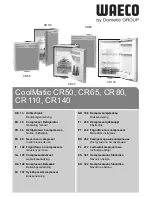
9
Door Open Alarm:
Your unit will sound an alarm when the door is open for longer than 60 seconds. To disable this:
1.
Follow the Setting Parameters instructions on page 8.
2.
Find parameter
do2
.
3.
The default for the unit is set at
1
(Enabled).
4.
To disable the alarm, set the parameter to
0
(Disabled).
5.
Press the
key, or press no key for 30 seconds, to exit. The temperature set-point will be
saved automatically.
Low Temperature Alarm:
To set a low temperature alarm:
1.
Follow the Setting Parameters instructions on page 8.
2.
Find parameter
A5
.
3.
Use the Use the and
keys to adjust the temperature.
4.
Press the
key, or press no key for 30 seconds, to exit. The temperature set-point will be
saved automatically.
High Temperature Alarm:
To set a high temperature alarm:
5.
Follow the Setting Parameters instructions on page 8.
6.
Find parameter
A6
.
7.
Use the Use the and
keys to adjust the temperature.
8.
Press the
key, or press no key for 30 seconds, to exit. The temperature set-point will be
saved automatically.
Alarms
Various alarms will sound under certain conditions if the unit’s buzzer is enabled. Below is a table
listing the unit’s alarm codes and causes:
Alarm Code
Causes
E1
Cabinet temperature sensor fails.
E2
Evaporator sensor fails.
E3
Condenser sensor fails.
cH
High condenser temperature alarm
rH
High cabinet temperature alarm
rL
Low cabinet temperature alarm
Controls for Dial Thermostats
•
Some units in this collection include a dial thermostat located inside the unit on the upper-right
side wall.
•
Turn the knob clockwise from the
0 (OFF)
position toward the higher numbers for colder
temperatures. Higher settings on the dial (higher numbers) mean lower temperatures (colder) in
the unit.
•
Changes in the ambient temperature affect temperature in the unit, so choose an appropriate
setting of the thermostat dial, depending on ambient conditions.


































